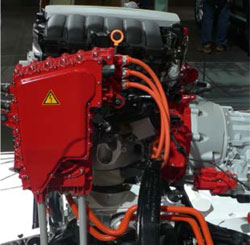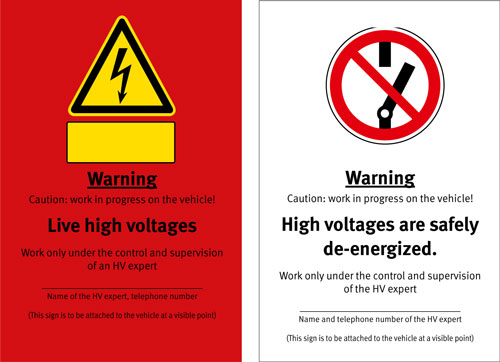Abschnitt 3.3 - 3. Risk assessment
Under the German occupational safety and health act, the employer is obliged to assure and if necessary improve the protection of employees' safety and health. An important step in this context is risk assessment.
Risk assessment is a process for identifying hazards and evaluating the associated risks. Evaluation of the hazards is a precondition for the taking of effective OSH measures relevant to the company.
Risk assessment consists of:
Systematic identification and evaluation of relevant hazards,
Definition of appropriate OSH measures.
One source of hazards are unsuitable qualifications of and instructions to the employees.
All OSH measures must comply with the general principles of hazard prevention set out in the German occupational safety and health act. The principle of hazard minimization must be applied. Owing to their higher vehicle electrical system voltages and electrical energy, HV systems present a hitherto unknown level of electrical hazard. A risk exists of irreversible injury following electric shock or arcing.
The spatial and temporal coincidence of the hazards and human beings must be prevented by suitable measures.

Basic protection by isolation and shrouding
Measures are classified as follows:
Technical, e. g. isolation, fixed shrouding,
Organizational, e. g. the observance of specified waiting times to allow for the dissipation of voltage,
Personal, e. g. personal protective equipment (insulating gloves, helmet with visor), instruction.
A combination of these measures is also possible. Technical measuresare to be given priority over organizational or personal measures.
The protective measures implemented in the vehicles differ from one manufacturer to another. The protective measures are such that no single fault alone is able to present an electrical hazard to persons. A selection of protective measures which have been implemented in various vehicles are listed below:
Disconnection of the entire HV system by means of an isolating facility (such as service disconnect, maintenance plug),
Plug-and-socket arrangement for all cable connections,
Components and plug-and-socket connections to at least IP 2X in the disconnected state, to at least IP 4X in the connected state, to EN 60529 (VDE 0470-1),
Safety loop (interlock) for all HV components; plug-and-socket connections with at least single-fault tolerance,
Shrouds of parts that are live and not protected against direct contact can be removed only by means of tools or by destruction,
Disconnection of the system voltage by means of early-breaking plug contacts when plug-and-socket connections are broken, for the prevention of fault arcs,
Disconnection of electrical circuits when covers are opened, possibly including the engine cover,
Mechanical arrangements for the removal of components/opening of covers and shrouds requiring a time greater than the discharge time for the residual voltages,
Permanent, built-in facility for determining the non-live state of the HV system,
Uniform, clearly identifiable marking of all HV components, for example by orange conductors,
Creation of an electrical system which is not earthed and which is isolated against the vehicle earth and the individual conductors,
Monitoring of insulation of the live conductors against vehicle earth,
Deliberate discharge of residual energy from the energy storage components, such as capacitors,
Connection of all exposed conductive vehicle parts by potential equalization in order to prevent the formation of different potentials.
A model risk assessment for an automotive workshop can be found in Annex 1.
Where suitably combined, technical measures alone are sufficient to ensure complete protection against electric shock and arcing from the HV system. The vehicle can then be described as having an "intrinsically safe HV system".

